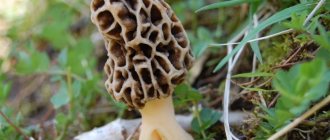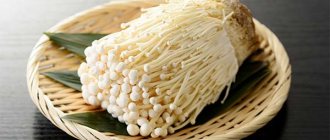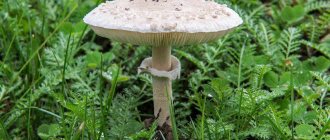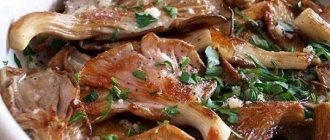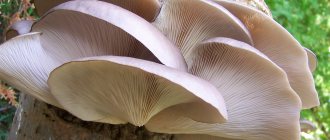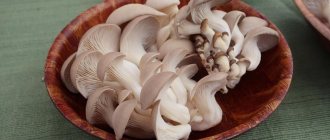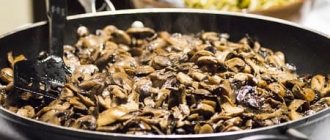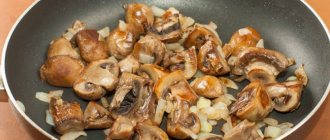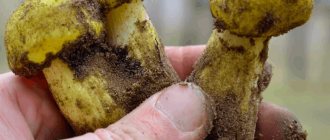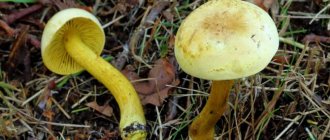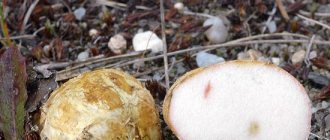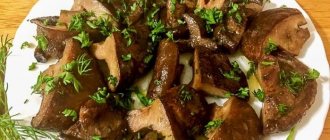Winter honey fungus, as enoki mushrooms are also called (Flammulina velutipes), are small mushrooms on thin, rather long stalks with small caps that have a white or pale yellow tint.
About three centuries ago, inconspicuous white mushrooms were discovered that had grown over trees in the forests of the Land of the Rising Sun. Then they began to be used in cooking, adding them to all kinds of local soups. The healers of that time dried enoki and made healing infusions from them.
Later, they decided to start growing these mushrooms artificially. At first this was done on trees, but now new technologies make it possible to grow enoki in plastic bottles, but only in a dark place.
This type of mushroom is popular in the cuisines of Korea, Japan, China and Thailand. You can also buy them from us. But stores offer only artificially grown porcini mushrooms.
Today, enoki is widely used in cooking, for medicinal purposes and in cosmetology.
How to choose
When choosing enoki of wild species, one must take into account the fruiting time, which occurs in the autumn-spring period. Interestingly, these mushrooms tolerate any low temperatures well. At the same time, cultivated varieties are collected almost throughout the year. Cultivated species differ from wild enoki in their almost white caps and long, very thin legs. To choose the highest quality mushrooms, both among wild and cultivated varieties, you should pay attention to the aroma and appearance of the caps. So, the mushrooms should have a pleasant smell, and the cap should not have dark spots.
How to store
If you buy enoki fresh, you can store it in the refrigerator in paper, but you should use it within a week. For long-term storage, the product can be pickled or simply frozen. If the storage temperature does not exceed -18 degrees, enoki will be edible for about 10-12 months.
In addition, it is worth knowing that these mushrooms must be stored away from other products, placed in a bag in a plastic container, or in a plastic or glass container that closes hermetically.
In cooking
The classic use of enoki is adding them to a variety of hot dishes and all kinds of soups. So, in Japan they like to cook soup from vegetables and mushrooms. To do this, first boil the vegetables, and add enoki 5 minutes before they are ready.
Of course, later the number of dishes with these mushrooms increased, since their versatility and ability to be combined with almost all products was noted. Now they are often added to barbecues, baked meat and fish dishes, cutlets, to various salads, rolls and sushi (as a filling), as well as to vegetables that are fried or baked.
Culinary experts say that enoki is much easier to cook than other types of mushrooms. So, you need to cut off the spongy base and rinse under running water. After this, enoki can be eaten, as they are considered raw food food. However, doctors still insist on preliminary heat treatment with warm water, which will ensure easier absorption of the product.
If you cook enoki, you need to know that you don’t need to keep it on the fire for a long time. Interestingly, when boiled, in which mushrooms are often served as a side dish, they taste similar to the yolk of a chicken egg. You can also fry the mushrooms, but you have to be careful because if the enoki is overcooked, it will be tough.
In Japan, one of the most popular enoki dishes is beef with mushrooms. For this dish, the meat is first prepared, and at the end the mushrooms are added and simmered all together for about 10 minutes.
Calorie content
Enoki is not only low in calories (only 22 kcal), but also rich in protein, which allows these mushrooms to be used in dietary nutrition.
Nutritional value per 100 grams:
| Proteins, g | Fats, gr | Carbohydrates, g | Ash, gr | Water, g | Calorie content, kcal |
| 3,09 | .0,34 | 3,26 | 0,2 | 92,45 | 22 |
Delicate edible cloves
Enoki are delicious mushrooms. Tips and Recipes
Enoki mushrooms, or enokitake, are an exquisite Asian delicacy. In our country they are known under the modest name Openok Winter Flammulina Velutipes. In nature, these mushrooms grow in autumn and winter (!) on the trunks and stumps of deciduous trees, but because of their wonderful taste they have long been grown artificially in large quantities. Therefore, to enjoy them, you don’t have to go hunting for exotic winter mushrooms: just look at the nearest supermarket and find them ready for cooking. In Russia, Enoki mushrooms are not yet as well known as the ubiquitous champignons, but, undoubtedly, their popularity will gradually grow, as will the volume of their annual production, which is already approaching 100 thousand tons per year.
"Wild" enoki have large brown hats and short legs, but in cooking they usually use "cultivated" ones - white, with tiny hats and long legs - such as spaghetti or curved cloves.
Enoki are delicious mushrooms.
Straw Mushroom (Volvariella edible, Herbal Champignon, Rice Straw Mushroom, Head Fang)
The white “pebbles” in the first photo on the left are straw mushrooms. Young mushrooms are hidden in the shell. They reach the size of a chicken egg, and then crawl out of their “cocoon”. The photo below shows how a straw mushroom “hatches”.
Straw mushroom
Straw mushroom in section
They are practically tasteless, but have a delicate texture, closest in taste to champignons. They have a silky surface and leave a pleasant smooth feeling on the tongue. Used in the preparation of the famous Tom Yum and Tom Kha soups.
Tom Yum soup
These mushrooms are also used in meat and poultry dishes.
chicken with mushrooms and onions in oyster sauce
and also in salads
Yum Hed Con, Spicy Straw Mushroom and Shiitake Mushroom Salad
The mushrooms are grown on mats made of rice straw, hence their name.
Before cooking
Enoki are delicious mushrooms.
Tips and Recipes Before using enoki, rinse them thoroughly with running water and cut off any remaining spongy base.
Enoki are full-fledged edible mushrooms and, in theory, their pulp can be eaten raw, but it is usually customary to subject them to heat treatment, which emphasizes their delicate aroma and delicate fruity taste. Enoki are actively used as an ingredient in sauces, soups, vegetable stews and a variety of meat dishes. Their taste goes well with soy, noodles, bacon, ginger and various seafood. Enoki mushrooms can be wrapped in buns or bacon slices and used in a variety of vegetable and meat salads.
Useful tips and tricks
Enoki, like other types of zukaryotic organisms, require special treatment when used for culinary purposes, therefore, in the process of creating a dish, the following rules must be taken into account:
- To obtain tasty and healthy food for the body, it is recommended to use winter mushrooms in exceptionally fresh and high-quality condition. The growing season of wild mushrooms is autumn - spring. It should be borne in mind that Enoki collected in winter are not wormy.
- When choosing mushrooms, you need to pay attention to their appearance. Preference should be given to intact specimens with a pleasant mushroom aroma and elastic flesh, with intact white caps without dents or spots uncharacteristic of this type.
- The presence of mucus on winter mushrooms indicates that their shelf life has expired. If there are any signs of deviations from the recommended characteristics of the product, it is better not to risk the health and quality of future food - simply dispose of suspicious specimens.
- Tender and fragrant winter mushrooms have long been considered an excellent component for preparing a variety of oriental soups. Moreover, mushrooms were added not only as a satisfying and nutritious ingredient, the best substitute for meat, but also to decorate the finished dish.
- “Japanese snowdrops” taste especially delicious in salads, where it is recommended to add the product raw.
- An excellent option would be winter mushrooms rolled into sushi or spring rolls, wrapped in thin layers of beef or bacon.
Mushrooms called “Enoki” go well with almost all foods, so you can cook them, for example, with noodles, lemongrass, soy, ginger, fresh herbs, butter and countless different seafood.
Enoki
Winter honey mushrooms, also called enoki mushrooms (Flammulina velutipes), are small mushrooms on thin, rather long stalks with a small cap that has a white or pale yellow tint.
About three centuries ago, inconspicuous porcini mushrooms were discovered and covered with trees in the forests of the Land of the Rising Sun. Then they began to be used in cooking, adding to all sorts of local soups. The healers of that time dried enoki and made medicinal infusions from them.
Later they decided to start growing these mushrooms artificially. At first it was done on trees, but now new technologies make it possible to grow enoki in plastic bottles, but only in a dark place.
This type of mushroom is popular in the cuisines of Korea, Japan, China and Thailand. You can also buy them from us. But only artificially grown porcini mushrooms are sold in stores.
Today, enoki is widely used in cooking, for medicinal purposes and in cosmetology.
How to choose
When choosing enoki of wild species, it is necessary to take into account the fruiting time, which falls in the autumn-spring period. Interestingly, these mushrooms tolerate low temperatures well. In addition, cultivated varieties are harvested almost all year round.
Cultivated species differ from wild enoki in the almost white shade of the cap and long and very thin legs. To select the highest quality mushrooms, from both wild and cultivated varieties, it is worth paying attention to the aroma and appearance of the caps.
Thus, the mushrooms should have a pleasant smell, and there should be no dark spots on the cap.
How to store
If you buy fresh enoki, you can store it in the refrigerator in paper, but you should eat it within a week. For long-term storage, the product can be pickled or simply frozen. If the storage temperature does not exceed -18 degrees, enoki will be edible for about 10-12 months.
It's also worth knowing that these mushrooms should be kept away from other foods by placing them in a bag in a plastic container or in a plastic or glass container that seals tightly.
In cooking
The classic use of enoki is to add them to various hot dishes and all kinds of soups. So, in Japan they like to cook vegetable and mushroom soups. To do this, first boil the vegetables and add enoki 5 minutes before cooking.
Of course, later the number of dishes with these mushrooms increased, as their versatility and ability to be combined with almost any food were noted. Now they are often added to kebabs, baked meat and fish dishes, cutlets, various salads, rolls and sushi (as a filling), as well as fried or baked vegetables.
Cooking experts say enoki is much easier to prepare than other types of mushrooms. Next, you need to cut the sponge base and rinse under running water. After this, enoki can be eaten as it is considered raw food. True, doctors insist on preliminary heat treatment with hot water, which will ensure easier absorption of the product.
Important
If you are going to cook enoki, then you need to know that it is not necessary to keep it on the fire for a long time. Interestingly, when boiled, in which mushrooms are often served as a side dish, they taste like the yolk of a chicken egg. Mushrooms can also be fried, but you need to be careful because if you overcook the enoki, they will turn out tough.
In Japan, one of the most popular enoki dishes is beef with mushrooms. For this dish, the meat is first prepared, and at the end the mushrooms are added and simmered together for about 10 minutes.
Calorie content
Enoki are not only low in calories (only 22 kcal), but also rich in protein, which makes it possible to use these mushrooms in dietary nutrition.
Nutritional value per 100 grams:
| Proteins, g | Fat, g | Carbohydrates, g | Ash, gr | Water, g | Calorie content, kcal |
| 3,09 | .0,34 | 3,26 | 0,2 | 92,45 | 22 |
Enoki is considered an excellent source of the antioxidant selenium and B vitamins, which help relieve fatigue and stress.
In addition, these mushrooms are rich in microelements such as calcium, potassium and iron, and contain the polysaccharide flammulin.
Useful and healing properties
Since scientists attribute antitumor properties to flammulin, enoki can be considered an excellent prophylactic agent that protects against the development of tumors. In addition, these mushrooms improve digestion, which, coupled with their low calorie content, has made the product popular in the diet. In addition, the proteins in these mushrooms can replace meat for vegetarians.
Since enoki contains potassium, which helps lower blood pressure, the product is considered beneficial for hypertensive patients.
Since people today very often suffer from chronic fatigue, doctors recommend supplementing the diet with B vitamins, which are contained in significant quantities in enoki. Therefore, when you are stressed and overworked, you can safely include these mushrooms in your diet. Enoki also has good antioxidant properties.
Among other things, these mushrooms can significantly improve the functioning of the heart muscle and blood vessels, since their consumption can lower cholesterol levels, improve blood circulation and even normalize blood pressure and heart rate. In addition, mushrooms can stimulate hematopoiesis and improve the blood's ability to carry oxygen throughout the body.
Use in cosmetology
Enoki are also used in cosmetology. Therefore, extracts of these mushrooms are often added to relaxing creams and various masks.
Enoki are in principle harmless, one can only note their ability to cause allergies and intolerance in certain people. In this case, you should stop not only from eating mushrooms internally, but also from using creams and oils containing them.
A variety of mushrooms are widely used in Thai cuisine. It turns out that “wild” mushrooms grow not only in temperate climates, but also in the tropics, and Thais enjoy collecting them. But this is more of an entertainment and delicacy, and mushrooms “for every day” in Thailand are grown on farms.
Thai forest mushrooms look, frankly, very bad on fly agaric. During the season they are sold in markets and are expensive.
There are, of course, not so scary ones, for example, quite familiar russuls. But we are not yet mentally developed enough to eat mushrooms from the rainforest, so we will move on to growing mushrooms for now.
Oyster mushroom (Oyster Mushroom, Head Nangrom, เห็ดนางรม)
Perhaps the most popular, cheapest and most widespread mushrooms in Thailand. Oyster mushrooms have a very inexpressive taste, but have a very pleasant elastic and crispy texture, so they are usually used when washing French fries, although they are sometimes added to soups. Oyster mushroom legs are wooden and tasteless, so they are thrown away.
Straw Mushroom (Head Fang, เห็ดฟาง)
Straw mushrooms in Thailand are as popular as champignons in our country. They are also very similar in taste and consistency, but straw mushrooms look like natural ones =)) Their stem grows from a special “onion” in which young mushrooms are entirely hidden. Straw mushrooms are an indispensable ingredient in Tom Yum and Tom Ka soups.
If you don't have enough pickled or salted mushrooms, then straw mushroom is your choice. Here's how to marinate it under Thai conditions.
Shiitake (Head Home, เห็ดหอม)
Unlike other Asian mushrooms, shiitake has a very distinct taste and aroma (and not everyone likes it). Actually, translated from Thai it is called “fragrant mushroom”. Therefore, you need to use it carefully - literally five mushrooms are enough for a casserole made from a rich broth, and you should not overuse them in shiitake fries.
As is customary among the Chinese, shiitake is considered not only food, but also a healing and rejuvenating potion.
Outside, where shiitake is grown, it is sold dried. To alert such mushrooms, they need to be briefly immersed in cold water.
Black tree mushroom (Mu Er, Hed Hunu, เห็ดหูหนู)
These mushrooms have spread throughout the world from China. They are usually sold dried, but Thai stores almost always have fresh ones. Tree mushrooms have a gristly, crunchy texture, and a classic Thai-Chinese recipe using them is stir-fried chicken with ginger and tree mushrooms.
White tree mushroom
This mushroom comes more from the stock of a Chinese pharmacy than from a Thai kitchen, but it can be found everywhere in Thailand, so here it is. The white tree mushroom is a relative of the black tree mushroom, but is even more tasteless and gelatinous. The Chinese make sweets and soups; it is also considered medicinal.
Enoki (Enokitake, Golden Threads)
These mushrooms came to Thailand from Japan. Enoki looks very elegant - thin white carnations with neat caps at the end. Their flavor is very light and fresh and their texture is firm and crispy. Enoki is added to soups, salads and grilled dishes. They need to be added to the dish at the last moment, because due to long heat treatment, enoki loses all its shape and taste.
For all its exoticism, enoki are a common winter honey mushroom. I just grew up in pitch darkness. Wild enoki mushrooms are brown in color and have a much shorter stem.
Eringi
Eringi, or, in Russian, steppe oyster mushroom, is a relative of the common oyster mushroom. It differs from them in having a thick barrel-shaped leg, which is actually used for food. Unlike oyster mushrooms, the stem of heather is quite soft and elastic, and also has a more mushroomy taste and aroma.
This mushroom is not particularly Asian: it grows spontaneously in the steppe zone of Russia and in the Mediterranean. He recently came to Thailand with a mushroom hobby from neighboring countries and has not yet found a special recipe for it.
Description
First of all, let's look at what enoki looks like. From the point of view of most known mushroom cultures, the fruits we study have a specific appearance:
- The legs of the mushroom are very thin, long, and resemble stalks.
- The caps are tiny, disproportionate to the legs, similar to small caps.
- Color white or light yellow.
They are distinguished by their delicate pulp with a delicate aroma and slightly fruity taste, which appears after heat treatment.
Beneficial features
As for beneficial properties, mushrooms are saturated with a large amount of vitamins B (1, 2, 3, 5) and D, calcium, iron, polysaccharides and potassium. At the same time, there are only 22 kcal per 100 grams, which means they can deservedly be considered a dietary product. Pharmaceutical studies of the culture have shown that eating the fruit has a beneficial effect on the body, namely:
- It has an antitumor effect and prevents the occurrence of tumors.
- Normalizes the functioning of the digestive system (if a person does not have chronic diseases of the gastrointestinal tract).
- Promotes weight loss for people following appropriate diets.
- They reduce blood cholesterol levels and also help the body cleanse itself of toxins.
- Normalizes blood pressure in hypertension.
In addition to the listed benefits, mushrooms are widely used in cosmetology. Specialists and traditional healers obtain extracts and tinctures from the fruiting bodies, on the basis of which effective rejuvenating (tonic) products are created.
Contraindications
The list of contraindications for the plant is very meager - the delicacy is contraindicated for people with individual intolerance and possible allergic reactions to one of the components of the pulp. Even children can be treated to honey mushrooms, since this particular variety is considered light and safe for digestion.
Recipes
Fried Enoki Mushrooms
Enoki are delicious mushrooms. Tips and Recipes
This recipe brings out the pure taste of the Chinese delicacy in its simplest fried form and at the lowest price.
Required:
- Enoki mushrooms - 200 gr.
- Soy sauce to taste.
- Salt, pepper and spices to taste.
- Oil.
Cooking:
- Peel the mushrooms and wash thoroughly.
- Fry the mushrooms in oil for 5-7 minutes, stirring constantly.
- At the end of the frying process, add soy sauce - it will favorably improve the taste of enox.
The dish is ready!
Salad with crab sticks, enoki mushrooms and vegetables
This salad is light and delicious with simple ingredients and doesn't take long to prepare.
Required:
- Enoki mushrooms - 420 gr.
- Crab sticks - 110 gr.
- Green beans - 120 gr.
- Fresh cucumber - 1 medium size.
- Sweet bell pepper - 1 pc.
- Onions - 1 medium size.
- Balsamic vinegar - 1 tbsp.
- Vegetable oil - 2 tbsp.
- Salt, ground black pepper, basil - to taste.
Cooking:
- Rinse the green beans and boil for 5 minutes, then cool sharply by placing them in cold water.
- Cook enoki for 10 minutes.
- Cut the crab sticks and cucumber into thin strips, finely chop the onion.
- Peel and wash the pepper and cut it into thin strips.
- Stir the vegetables, add salt and pepper, add oil and vinegar, then mix everything well and add the basil.
- Boiled enoki must be added to the salad before serving.
The dish is ready!
Enoki soup in fish broth with Chinese radish
Thanks to the characteristic, but not complex ingredients, you can enjoy the taste of a real Asian dish.
Required:
- Enoki mushrooms - 120 gr.
- Daikon (Chinese radish) - 1 piece medium size.
- Strong fish broth - 2 liters.
- Shrimp - 210 gr.
- Okra (okra) - 310 gr.
- Chicken egg - 2 pieces of the highest category.
- Green onion - 1 bunch.
Cooking:
- Grind the daikon and grate it.
- Cut the okra into small rings, chop the green onions, and divide the large shrimp into two parts.
- Bring the fish broth to a boil, add salt, add daikon and okra, and after boiling, cook the broth for six minutes.
- Add enoki and half the green onions and cook for another 4 minutes.
- Beat the eggs with a whisk and add them to the soup, then cook for another minute.
The dish is ready! Before serving, add the remaining green onions to the soup.
Restoration of antitumor immunity
Cell degeneration is a completely familiar and natural process for the body. It is associated with errors in the DNA of the cell, certain failures during its formation. Any of these atypical cells can cause the development of cancer. But the body itself successfully fights them with the help of the immune system. This is done by special lymphocytes. They track abnormal cells and eliminate them.
The antitumor immune system may be weakened due to natural causes or due to external factors . The first include age-related characteristics of the body. Lymphocyte activity in children under 5 years of age and the elderly is below the statistical average. The second is the style and living conditions of a person. Stress, toxin poisoning, and aggressive drug treatment can lead to “putting to sleep” lymphocytes.
Enoka contains Flammulin , which promotes the emergence of new immune defenders, their accelerated growth and increased cytological activity. The effectiveness of anti-cancer immunity depends on their number and combat effectiveness. This is extremely important, because it is much easier to cope with an oncological tumor at the stage of its formation.
Cold appetizer with Enoki mushrooms
In Chinese national cuisine, this delicacy is called Liangban Jinzhengou, it is extremely popular and is often found on the table along with fatty dishes, since the rice vinegar it contains is best for digestion.
Ingredients
To prepare the snack you will need:
- granulated sugar - 2 tbsp.
- fine salt - ½ tsp;
- Azzinomoto weijin (seasoning) - ½ teaspoon;
- Rapeseed oil soaked in huajiao - 2 tbsp;
- Soy sauce - 2 tbsp;
- Canned jenoki mushrooms (golden threads) - 2 jars;
- Rice vinegar (black) - 2 tbsp. L;
- Carrots - 2 pcs;
- Cucumbers - 2 pieces;
- Sesame oil - 2 tbsp. L;
Fresh produce is a good substitute for canned mushrooms. In the Middle Kingdom, vegetables are used in the same way as almost all seasonal fruits, from which a wide variety of culinary compositions are created.
Step-by-step cooking process
Procedure for creating a dish:
- First, peel the vegetables, then cut the cucumbers into strips.
- Carrots should be cut in the same way. It is best to grind the root on a special Korean vegetable grater.
- Now heat drinking water in a saucepan. When it boils, you need to add salt to the liquid, then add the carrot mixture, blanch the product for 2 minutes.
- After this time, you should remove the vegetables, immediately place them in a bowl of ice water, leave them chopped for 2 minutes, then squeeze out the mixture, transfer to a large bowl.
- In the meantime, drain the brine from the honeydew, drain the mushrooms in a colander, rinse the food well and leave the mushrooms in the same bowl to drain off excess moisture.
- Then mix vinegar, sesame oil, white granulated sugar, light soy sauce, Weijing seasoning, salt and Huajiao pepper oil in a bowl. The resulting mixture should be mixed well.
All that remains is to place the processed vegetables in the dish, pour the aromatic sauce over the mixture and carefully distribute among all the ingredients of the appetizer.
Use of culture in cooking
Representatives of Asian cooking and other oriental trends prefer to add the mushrooms we are considering to savory soups, sauces and other hot dishes. However, the list of dishes with enoki is growing every year: sophisticated experiments show that the product goes well with all types of vegetable stews, meat dishes and even sandwiches.
How to cook enoki? - Check out this super recipe!
The basic principle of preparing enoki is rapid heat treatment. Regardless of what dish the product is added to, it does not have to be raw (with the exception of some types of rolls or sushi). This type of honey mushroom is usually boiled or fried, but not more than 7-10 minutes. If you overcook the dish, the ingredient will harden, resembling tasteless chewing gum.
Before cooking, mushrooms are chopped and washed thoroughly under running water. There are no other golden rules.
If you have never tried this unknown mushroom, be sure to correct this omission.
Check out this great and easy salad recipe.
Shimiji (Lyophyllum shimeji)
© flickr.com
Mushrooms that are exactly the same as honey mushrooms, nevertheless differing from them no less than a hint. They taste like oyster mushrooms, except that the intensity is a little higher. They require mandatory, albeit minimal, heat treatment. If you eat them raw, you won’t get poisoned, but they will be difficult to digest—such a test of the strength of your digestive system is definitely not needed. In addition, they are bitter when fresh, but the bitterness disappears literally after three to four minutes of frying or boiling.
You can add them everywhere - stew, boil, fry. Shimiji are absolutely universal, considered one of the most popular in Asia, second only to our famous shiitake.
Recipes for dishes with winter mushrooms
Enoki mushrooms have the remarkable ability to pair well with any other food. They are often added to kebabs, meat and fish dishes, cutlets, salads and baked vegetables. And sandwiches and pies filled with winter mushrooms taste excellent and will decorate the holiday table. Washed enoki can also be eaten raw. These mushrooms are readily consumed by raw foodists, but doctors still recommend cooking them, even if only for a short time.
Recipes with enoki
- Vegetable salad with enoki and crab sticks. Ingredients: 120 g green beans, 420 g enoki, 100 g crab sticks, fresh cucumber, 1 onion and 1 pepper. Also take ground black pepper and salt to taste, 2 tablespoons of vegetable oil, 1 tablespoon of balsamic vinegar and 5 g of fresh basil. Wash the beans and boil for 5 minutes, then cool with cold water. Cut off the bottom of honey mushrooms and boil for 10 minutes. Chop all salad products, pour in a mixture of vegetable oil and vinegar. Add pepper and salt, basil leaves. Eat your health!
- Chinese salad with enoki mushrooms. We will need 1 pack of winter mushrooms, 1 fresh cucumber, 50 g of glass paste. For the marinade, take 250 g of water, 2 peas, 1 clove, 1 bay leaf, sugar, salt and vinegar to taste. Season the salad with soy sauce (3 tbsp), lemon juice (2 tsp), ginger juice (1 tsp), odorless vegetable oil (3 tbsp). Take salt, sugar and pepper to taste. First, wash the mushrooms, then marinate them for 2 minutes in a marinade prepared from the indicated products. Cool the enoki and store in the refrigerator for 24 hours. Now let's prepare glass noodles: pour boiling water over the product, let sit for 5 minutes, then drain the liquid. Next, cut the cucumber into thin slices. Add to cold noodles, add mushrooms without marinade. Mix all the ingredients of the dressing and season our salad. Leave for 30 minutes and serve. Fresh cilantro goes well with this oriental dish.
- Mushroom salad with golden thread. Ingredients: 180 g winter mushrooms, 30 g carrots, 50 g cucumbers, 4 ml soy sauce, 10 ml balsamic vinegar, 5 g honey, 30 g roasted sesame seeds, salt and herbs to taste. First, wash the mushrooms, cut the root system and cook in brackish water for 10 minutes. Pour in the liquid, cool the enoki and place on a plate. Add chopped cucumbers and chopped green onions to the mushrooms. Fry the grated carrots and add to the salad. Mix all products and add salt, honey, roasted sesame seeds. Prepare the filling from vinegar and sauce and season our dish with an unusual taste.
- Enoki cold appetizer. This dish is most often prepared in China. It is easy to prepare and goes well with fatty foods. For such a snack, you can take both fresh winter mushrooms and canned ones. Chop the cucumbers and carrots (if you have other vegetables, they will work too), place them on the plate with the enoki and mix everything together. The dressing for the appetizer consists of sesame oil, soy sauce, black rice vinegar, huajiao oil and weijing dressing. You can choose the quantity of ingredients for the dish according to your taste.
- Beef with enoki mushrooms. First, marinate 600g beef in 3 tablespoons apple cider vinegar salt for 3 hours. Then salt the meat (salt to taste) and simmer in a deep frying pan in vegetable oil (2 tablespoons), covered with a lid for about 1 hour. When finished cooking, season the beef (pepper to taste) and set aside in the same pan. Place 0.5 cups of fresh raspberries in the same bowl, mash slightly, add another 2 tablespoons of vinegar and mix with meat. Now we wash the mushrooms in an amount of 150 g, cut their root system so that they break up into separate parts. Place them in a pan with meat and raspberry dressing and simmer for another 10 minutes. The dish is ready!
- Light soup with enoki. Ingredients: 1 small daikon, 2 liters of fish broth, 120 g of mushrooms, 2 eggs, a bunch of green onions, 210 g of shrimp, salt to taste and 200 g of okra to taste. Grate the daikon on a Korean grater, cut the okra into rings, chop the onion, cut the shrimp into 2 parts. First, cook the daikon and okra in the broth for 6 minutes. Then add enoki, shrimp and onions. Cook these foods for another 5 minutes. Salt and pepper. Pour in the beaten eggs. Eat this soup with an unusual taste and unusual ingredients to prepare!
- Enoki soup with chicken broth. We will need the following products: 2 potatoes, carrots, onions, 2 liters of chicken broth, 2 tablespoons of vegetable oil, salt to taste and, of course, 100 g of winter mushrooms. We wash and peel the vegetables. Chop the potatoes and onions, grate the carrots on a coarse grater. First, prepare the frying by frying the onions and carrots in vegetable oil. Then cook the soup in the broth: boil the potatoes, add fried and bottomless mushrooms about 10 minutes before the end of cooking. Add salt and vegetables to taste.
- Enoki mushrooms wrapped in bacon. For this recipe, take 12 mushrooms without the root system. Wrap each enoki in a thin piece of bacon and fry the resulting “hemp” in vegetable oil. Place them on a plate. Cut the lemon into 8 pieces and place on a plate. Garnish with green salad. Sprinkle with lemon juice and eat.
- Noodles with chicken and enoki mushrooms. We take ingredients for the dish in any proportion. Cut 1 pepper into strips. Cut chicken fillet (2 pieces) into small pieces. Pour 3 tablespoons of vegetable oil into a deep, thick-walled frying pan and fry the meat with pepper, adding sesame seeds and salt to taste. The salad can be torn with your hands and also fried along with chicken fillet. Separate the enoki (150 g) from the base and place them in a non-stick pan, also adding soy sauce. All products that we fry are thoroughly mixed and covered with a lid. Fry the chicken until done. Boil the noodles separately. Drain the water and put it in a saucepan with the rest of the ingredients.
- Fried winter mushrooms. To prepare mushrooms by frying, we will need vegetable oil, onion, garlic, 1 bell pepper, salt and garlic to taste. The first step is to rinse the enoki and separate it from the base. Then fry the chopped onion and pepper in vegetable oil. About 10 minutes before the end of frying, add the mushrooms to the pan. Add salt and garlic, passed through a garlic press. You can also add carrots to this dish. Winter mushrooms go great with rice.
Practical application of Enokitake
Among the variety of Enoki-based products, two of the simplest and most effective can be identified:
- Powdered drink . In 200 ml of warm water, stir 4 scoops (0.13 g sold as a set) of pure mushroom powder. Take twice: in the morning an hour before meals and in the evening an hour after meals.
- Infusion . Add 10 g of Enoki powder to 100 ml of vodka and leave for 2 weeks. Take 2-3 times a day, one tablespoon of infusion. The course of treatment is 3-4 months. Preventive course – no more than 60 days twice a year.
Over the past 10 years, numerous studies have been conducted to study the effects of the components of the Enokitake mushroom. Many experts call it the main hope for developing a stable vaccine against severe cancer. Cultivated for medicinal purposes, Enoki is already helping to save lives and restore health to seriously ill patients. Nature has preserved a lot of tips on how to deal with this serious and resourceful enemy. And one of them is this unsightly parasitic mushroom.
How to store the product
Familiarize yourself with food storage rules in case you don't cook right away.
- It is important to put the fruiting bodies in the refrigerator, after wrapping them in breathable paper. There is no need to rinse off the product; cleaning will be required before actually preparing the product.
- Make sure that enoki is stored separately from other foods; special food containers can be used for this.
Fresh mushrooms must be consumed no later than 5-6 days; for longer storage, you can resort to pickling or freezing boiled fruits, so the shelf life is extended to 9-10 months.
Oyster mushroom (oyster mushroom, Oyster Mushroom, Head Nangrom)
And finally, on the right in the first photo is an oyster mushroom. The taste of oyster mushroom is reminiscent of champignon, but more pungent. Young mushrooms (up to 7-10 cm in size) are used for food after removing the hard stem; old mushrooms become too tough.
Oyster mushrooms growing
Oyster mushroom fruit bodies are a valuable dietary product because they have low calorie content (38-41 kcal) and contain many substances necessary for the human body. In terms of protein content (15%-25%) and amino acid composition, oyster mushroom is superior to vegetable crops, except legumes, and is close to meat and dairy products. Polysaccharides beta-glucans (lentinan), isolated from oyster mushrooms, have a high antitumor and immunomodulatory effect; mannitol and chitin, which are part of the fiber fraction, are an effective sorbent of toxic substances. Among the minerals contained in oyster mushrooms are potassium, phosphorus, iron, as well as calcium, cobalt, selenium, zinc, copper and a number of other elements necessary for the human body.
oyster mushrooms
Oyster mushroom is an excellent source of both water-soluble and fat-soluble vitamins, comparable to meat products, vegetables and fruits. The fruiting bodies of oyster mushrooms contain the entire complex of B vitamins, as well as ascorbic acid, vitamin PP (5-10 times more than in vegetables), D2, E.
oyster mushroom
Fried with meat
This type of honey cake goes well with meat, which is why there are many different variations of this dish in oriental cuisine.
Ingredients
To prepare this dish you will need:
- table salt, sesame oil - at your discretion;
- ginger root - 20-30 cm;
- starch - 2 tbsp
- Enoki - 400 gr;
- Sunflower oil - for frying;
- pork - 400 gr;
- garlic cloves - 4 pcs;
- hot red pepper - 2 pcs;
- soy sauce - 2 tablespoons;
Step-by-step cooking process
Order of preparation steps:
- First you need to wash the meat, clean it of membranes and tendons, dry the piece well with a disposable napkin, then cut the pork into thin slices.
- Now you need to marinate the meat, to do this, put the product in a deep bowl, lightly salt the pieces, add starch and a few drops of sesame oil.
- The resulting mixture must be mixed well and left in this form while the remaining ingredients of the dish are processed.
- Next, separate the bottom of the stems from the enoki, rinse them thoroughly, drain off any remaining water, then separate the beech mushrooms from each other.
- Cut the peeled chilies in half and then into long, thin strips.
- Finely grate the garlic cloves and peeled ginger root.
- Then fry the vegetables. To do this, preheat a frying pan and then heat the sunflower oil.
- Then place the marinated meat in the heated fat and fry, stirring occasionally, until fully cooked. This process takes no more than 3-4 minutes. Leave the pieces in the pan longer to prevent the pork from drying out.
- Then remove the pork from the pan and add the ginger and garlic to the empty space, warming them gently over medium heat. When a slight aftertaste appears, add prepared mushrooms to the chili.
- Cook the mixture for no more than 1-2 minutes, stirring constantly. During this short time, the mushrooms will become soft, so you can add a little salt to them. This cooking stage is the most important in the cooking process. If you overcook the mushrooms for at least 1 minute, they will lose their tenderness and immediately become “rubbery.”
- Now add the meat to the mixture, turn off the heat and stir the ingredients.
The resulting delicacy tastes equally warm or slightly cold.
Sources
- https://gribysobiraem.info/jenoki-delikatesnye-griby-sovety-i-recepty/
- https://www.delikateska.ru/lenta/229
- https://lafoy.ru/shampinony-po-koreyski-recepty-1951
- https://azbyka-vkysa.ru/griby-po-korejski.html
- https://netgribov.ru/recipes/griby-po-koreyski.html
- https://iskitimcgb.ru/diagnostika/chto-mozhno-prigotovit-iz-gribov-enoki.html
- https://tutknow.ru/meal/9582-zimnie-opyata-enoki.html
- https://prorastet.ru/griby/griby-enoki-kak-gotovit-recepty-s-foto
- https://moi-gribi.ru/syedobnie/enoki
